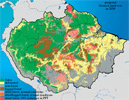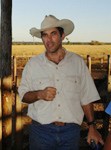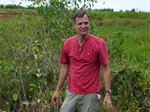Reducing Emissions from Deforestation and Degradation [REDD] programs that include landowners will conserve more habitat and ensure greater ecosystem services function than programs that focus solely on protected areas, report researchers from the Woods Hole Research Center (WHRC), the Instituto de Pesquisa Ambiental da Amazônia (IPAM), and the Universidade Federal de Minas Gerais (UFMG).
REDD, a proposed climate change mitigation mechanism that would compensate developing countries for keeping their forests standing, has emerged from relative obscurity to become a focal point of climate change negotiations over the past four years. But in rising to prominence, REDD has also become increasingly controversial. Among the concerns is that REDD will bias conservation activities towards high-carbon landscapes, leaving low-carbon ecosystems open to development, to the detriment of biodiversity and other ecosystem services.
 (a) The Xingu River headwaters region (outlined in blue), showing federal and state protected areas (yellow), indigenous territories (white), paved roads (red), and other major unpaved roads (black). Land cover is shown for a Landsat 5 TM mosaic from 2008; greener areas indicate presence of more native vegetation or higher biomass regeneration, pinker areas indicate cleared areas or areas of low native biomass. (b–d) Comparison of alternative landscapes representing the outcome of 3 possible REDD scenarios for the Xingu River headwaters in 2020: (b) Business as Usual (BAU); (c) Protected Areas and Riparian Zone Only (PARZ); and (d) Integrated Landscape Conservation (ILC) [under which private landowners are compensated for conservation measures]. Image and caption courtesy of WHRC/Global Change Biology. |
The authors, led by Claudia Stickler of WHRC, examined the potential of REDD to conserve ecosystems in the Xingu basin, an area of rainforest and dry tropical woodland known as cerrado in the southern Brazilian Amazon. While the cerrado stores less carbon than the adjacent rainforest — making it less of a candidate for REDD — it nonetheless plays an important role in watershed maintenance, serving as the source several major Amazon tributaries, including the Xingu river. The cerrado further supports a wealth of endemic plant and animal species.
But the cerrado is also suitable for intensive agriculture and cattle ranching. As such, the ecosystem is being lost at more than twice the rate of the Amazon rainforest, resulting in significant carbon dioxide emissions and harming its watershed functions, potentially undermining the very system that supplies water to farmers and ranchers in the region.
Modeling carbon stocks, river discharge, annual evapotranspiration, habitat quality, and water quality under under three legislation scenarios, Stickler and colleagues found that a carbon program which compensates avoided deforestation and forest restoration on private land would sequester more carbon (more than 200 times the avoided emissions) and provide better water services than a program that focuses on protected areas, riparian zones, and indigenous territories alone. Including private landowners in a REDD program would keep more forest standing — across a wider range of habitats — than a program that excluded them.
“We have demonstrated for a large-scale Amazon landscape that REDD could foster improved watershed function, and increase habitat quality and quantity (e.g., through increased forest connectivity and reduced edge effects),” the authors write. “The Xingu headwaters case study demonstrates that the ecological cobenefits of REDD are sensitive not only to the quantity of forests and woodlands remaining on the landscape, but also to their spatial distribution.”
“These results also provide further support to a shift in conservation theory that posits that landscape level conservation approaches are likely to secure ecosystem integrity better than those focused solely on protected or ‘core’ areas.”
The paper also includes a broader evaluation of co-benefits afforded by REDD. The authors found in most cases that REDD programs will boost carbon stocks and provide “substantial ecological cobenefits,” especially in schemes that focus on slowing destruction and degradation of old growth forests. The notable exception came in programs that seek carbon stock enhancement through tree plantations.
“We need a balanced approach to REDD as we get into the details of how this mechanism will work,” said co-author Dan Nepstad of WHRC in a statement. “Images of rainforests being razed for Eucalyptus plantations in the name of carbon are simply not helpful.”
“There are reasons to be concerned about possible ecological damages that could be caused by REDD, and to make sure that those damages are kept to a minimum, but the overwhelming evidence points to enormous ecological benefits overall, especially if REDD programs are well-planned,” added Stickler.
Claudia M. Stickler, Daniel C. Nepstad, Michael T. Coe, David G. McGrath, Hermann O. Rodrigues, Wayne S. Walker, Britaldo S. Soares-Filho, Eric A. Davidson. The potential ecological costs and cobenefits of REDD: a critical review and case study from the Amazon region [PDF]. Global Change Biology Volume 15, Issue 12, Pages 2803-2824 DOI: 10.1111/j.1365-2486.2009.02109.x
Related articles

(06/09/2009) A global framework on climate change must immediately halt deforestation and industrial logging of the world’s old-growth forests, while protecting the rights of forest communities and indigenous groups, said a broad coalition of activist groups in a consensus statement issued today at U.N. climate talks in Bonn Germany. The statement said the successor treaty to the Kyoto Protocol should not include mechanisms that allow industrialized countries to “offset” their emissions by purchasing carbon credits from reducing deforestation in developing countries, a position that puts the coalition at odds with larger environmental groups who say a market-based approach with tradable credits is the only way to generate enough money fund forest protection on a global scale.
Brazil’s plan to save the Amazon rainforest

(06/02/2009) Accounting for roughly half of tropical deforestation between 2000 and 2005, Brazil is the most important supply-side player when it comes to developing a climate framework that includes reducing emissions from deforestation and forest degradation (REDD). But Brazil’s position on REDD contrasts with proposals put forth by other tropical forest countries, including the Coalition for Rainforest Nations, a negotiating block of 15 countries. Instead of advocating a market-based approach to REDD, where credits generated from forest conservation would be traded between countries, Brazil is calling for a giant fund financed with donations from industrialized nations. Contributors would not be eligible for carbon credits that could be used to meet emission reduction obligations under a binding climate treaty.
Half the Amazon rainforest will be lost within 20 years

(02/27/2008) More than half the Amazon rainforest will be damaged or destroyed within 20 years if deforestation, forest fires, and climate trends continue apace, warns a study published in Philosophical Transactions of the Royal Society B. Reviewing recent trends in economic, ecological and climatic processes in Amazonia, Daniel Nepstad and colleagues forecast that 55 percent of Amazon forests will be “cleared, logged, damaged by drought, or burned” in the next 20 years. The damage will release 15-26 billion tons of carbon into the atmosphere, adding to a feedback cycle that will worsen both warming and forest degradation in the region. While the projections are bleak, the authors are hopeful that emerging trends could reduce the likelihood of a near-term die-back. These include the growing concern in commodity markets on the environmental performance of ranchers and farmers; greater investment in fire control mechanisms among owners of fire-sensitive investments; emergence of a carbon market for forest-based offsets; and the establishment of protected areas in regions where development is fast-expanding.
55% of the Amazon may be lost by 2030
(01/23/2008) Cattle ranching, industrial soy farming, and logging are three of the leading drivers of deforestation in the Brazilian Amazon. As commodity prices continue to rise, driven by surging demand for biofuels and grain for meat production, the economic incentives for developing the Amazon increase. Already the largest exporter of beef and the second largest producer of soy – with the largest expanse of “undeveloped” but arable land of any country – Brazil is well on its way to rivaling the U.S. as the world’s agricultural superpower. The trend towards turning the Amazon into a giant breadbasket seems unstoppable. Nevertheless the decision at the U.N. climate talks in Bali to include “Reducing Emissions From Deforestation and Degradation” (REDD) in future climate treaty negotiations may preempt this fate, says Dr. Daniel Nepstad, a scientist at the Woods Hole Research Institute.
Tropical forests face huge threat from industrial agriculture
(12/05/2007) With forest conversion for large-scale agriculture rapidly emerging as a leading driver of tropical deforestation, a new report from the Woods Hole Research Center (WHRC) suggests the trend is likely to continue with Brazil, the Democratic Republic of the Congo, Indonesia, Peru, and Colombia containing 75 percent of the world’s forested land that is highly suitable for industrial agriculture expansion. Nevertheless the study identifies forests that may be best suited (low population density, unsuitable climate and soils) for “Reduced Emissions from Deforestation and Degradation” (REDD) initiatives which compensate countries for preserving forest lands in exchange for carbon credits.
Amazon deforestation could be eliminated with carbon priced at $3
(12/04/2007) The Amazon rainforest could play a major part in reducing greenhouse gas emissions that result from deforestation, reports a new study published by scientists at the Woods Hole Research Center, the Instituto de Pesquisa Ambiental da Amazônia, and the Universidade Federal de Minas Gerais. At a carbon price of $3 per ton, protecting the Amazon for its carbon value could outweigh the opportunity costs of forgoing logging, cattle ranching, and soy expansion in the region. 2008 certified emission-reduction credits for carbon currently trade at more than $90 per ton ($25 per ton of CO2).
Can cattle ranchers and soy farmers save the Amazon?

(06/06/2007) John Cain Carter, a Texas rancher who moved to the heart of the Amazon 11 years ago and founded what is perhaps the most innovative organization working in the Amazon, Alianca da Terra, believes the only way to save the Amazon is through the market. Carter says that by giving producers incentives to reduce their impact on the forest, the market can succeed where conservation efforts have failed. What is most remarkable about Alianca’s system is that it has the potential to be applied to any commodity anywhere in the world. That means palm oil in Borneo could be certified just as easily as sugar cane in Brazil or sheep in New Zealand. By addressing the supply chain, tracing agricultural products back to the specific fields where they were produced, the system offers perhaps the best market-based solution to combating deforestation. Combining these approaches with large-scale land conservation and scientific research offers what may be the best hope for saving the Amazon.
Globalization could save the Amazon rainforest

(06/03/2007) The Amazon basin is home to the world’s largest rainforest, an ecosystem that supports perhaps 30 percent of the world’s terrestrial species, stores vast amounts of carbon, and exerts considerable influence on global weather patterns and climate. Few would dispute that it is one of the planet’s most important landscapes. Despite its scale, the Amazon is also one of the fastest changing ecosystems, largely as a result of human activities, including deforestation, forest fires, and, increasingly, climate change. Few people understand these impacts better than Dr. Daniel Nepstad, one of the world’s foremost experts on the Amazon rainforest. Now head of the Woods Hole Research Center’s Amazon program in Belem, Brazil, Nepstad has spent more than 23 years in the Amazon, studying subjects ranging from forest fires and forest management policy to sustainable development. Nepstad says the Amazon is presently at a point unlike any he’s ever seen, one where there are unparalleled risks and opportunities. While he’s hopeful about some of the trends, he knows the Amazon faces difficult and immediate challenges.














